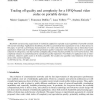Free Online Productivity Tools
i2Speak
i2Symbol
i2OCR
iTex2Img
iWeb2Print
iWeb2Shot
i2Type
iPdf2Split
iPdf2Merge
i2Bopomofo
i2Arabic
i2Style
i2Image
i2PDF
iLatex2Rtf
Sci2ools
JVCIR
2006
2006
Trading off quality and complexity for a HVQ-based video codec on portable devices
Bandwidth and processing requirements of multimedia applications typically exceed capabilities of portable terminals with current technology. Applications should hence be able to accommodate their requirements to run on these devices. In this paper, we provide a performance characterization of a video codec based on techniques such as hierarchical vector quantization which trade off complexity and reproduction quality. Comparison with standard codecs shows a remarkable reduction of coding times, such that real-time coding/decoding of video becomes possible even on low-power devices. This complexity reduction is counterbalanced by reproduction quality impairment. Nevertheless, for application such as videoconference, subjective quality seems to be fairly acceptable. Our analysis also quantifies some limitations of low-power devices with current technology.
| Added | 13 Dec 2010 |
| Updated | 13 Dec 2010 |
| Type | Journal |
| Year | 2006 |
| Where | JVCIR |
| Authors | Marco Cagnazzo, Francesco Delfino, Luca Vollero, Andrea Zinicola |
Comments (0)

